Nymphs
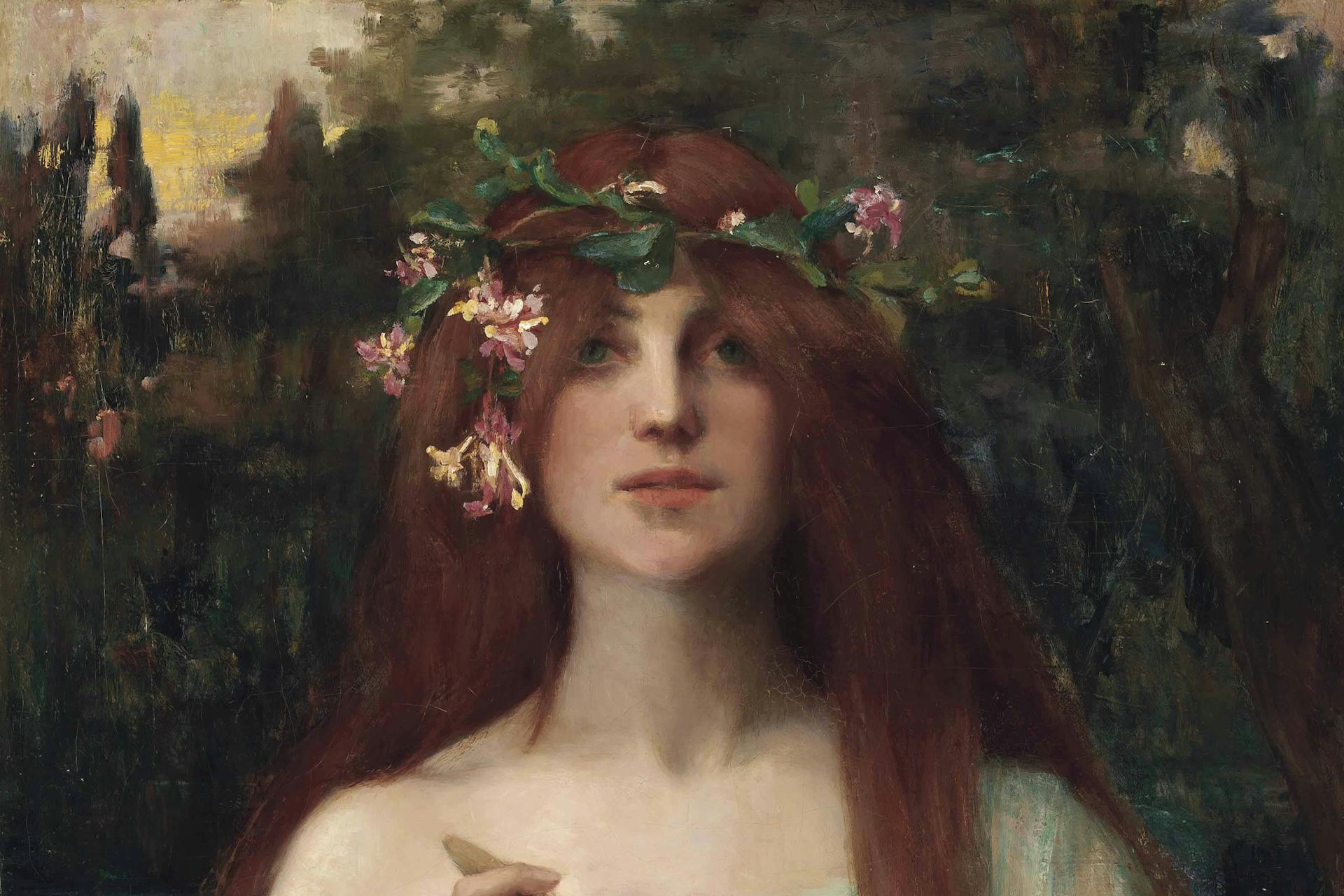
Nymph by Blanch Paymal-Amouroux (1899)
Wikimedia CommonsPublic DomainOverview
The nymphs were a loosely-defined category of minor nature goddesses. They were almost always imagined as beautiful young women. Representing and personifying the diverse aspects of the natural world, the nymphs could be divided into many subgroups. These included the Nereids, Naiads, and (occasionally) the Oceanids, who inhabited the water (the sea, rivers, and springs); the Oreads, who inhabited the mountains; the Dryads and Meliae, who inhabited different kinds of trees; and many others.
Nymphs were usually regarded as benevolent beings. In myth, they could often be found roaming through the woods, hunting, or watching over flocks. Some nymphs were the lovers or mothers of famous gods, heroes, and satyrs, and many places were thought to have been named for nymphs. Though they had extraordinarily long lifespans, they were not necessarily immortal.
In cult, nymphs were often worshipped in caves and groves, where they were closely associated with other woodland gods, such as Artemis and Pan. Nymphs were also invoked as patrons of herdsmen, hunters, and spurned lovers and were sometimes thought to possess miraculous healing powers.
Etymology
In ancient Greek, the word “nymph” (Greek νύμφη, translit. nýmphē) means “young woman” or “bride,” but the etymology of this word is uncertain. Some scholars have compared it to words with similar meanings in other Indo-European languages, including the Latin nubo (“to marry”), the Old Church Slavonic snubiti (“to love, to court”), and the Indo-European root *sneubʰ-. However, it is likely that “nymph” is ultimately pre-Greek in origin.[1]
Pronunciation
English
Greek
Nymph, Nymphs Νύμφη (Nýmphē), Νύμφαι (Nýmphai) Phonetic
IPA
[nimf], [nimfs] /nɪmf/, /nɪmfs/
Attributes
General
The ancient Greeks did not have an exact definition or taxonomy of nymphs.[2] There were, however, a handful of attributes that usually distinguished these beings.
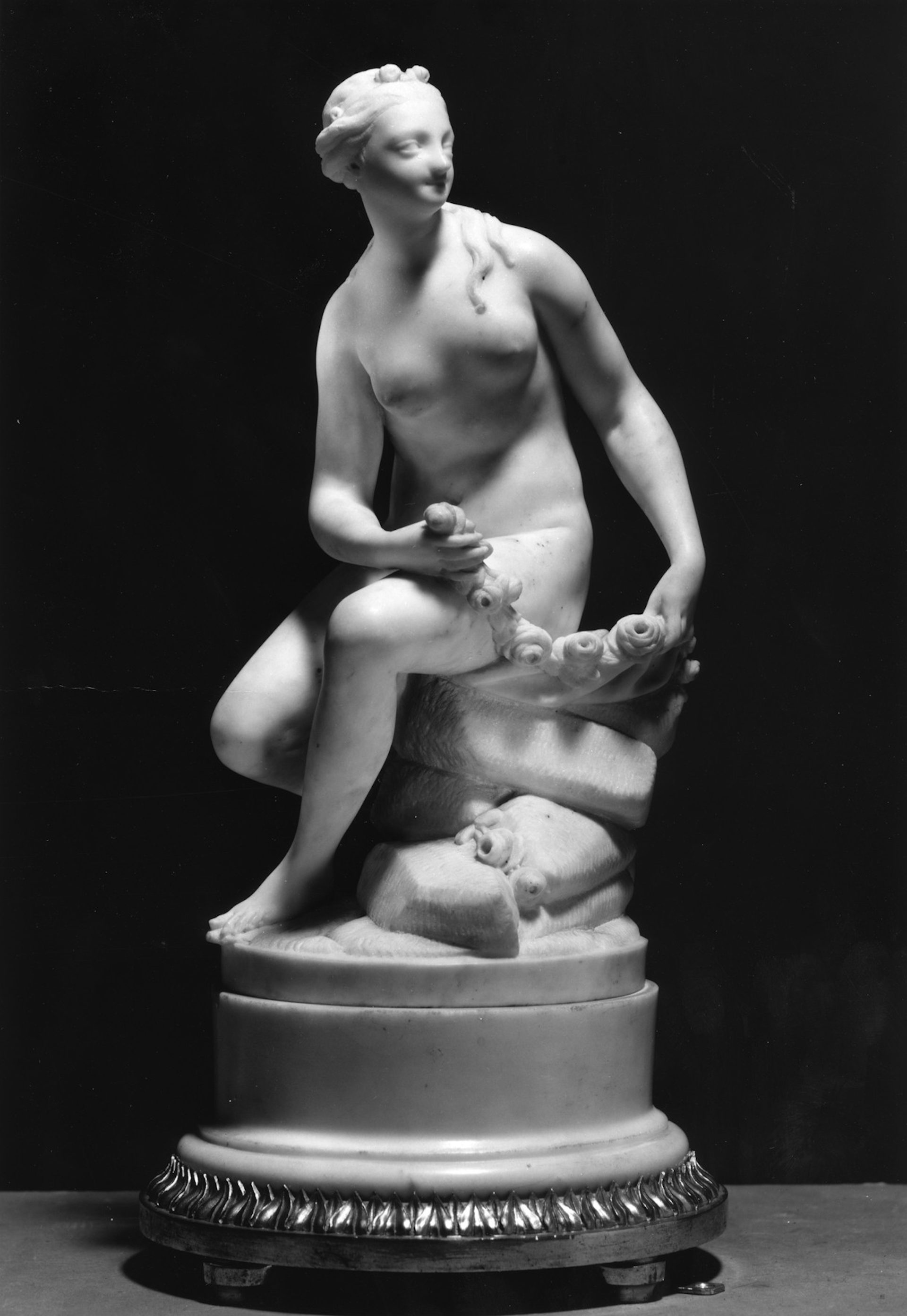
Nymph Seated, possibly by Etienne-Maurice Falconet (18th century)
The Walters Art MuseumCC0Nymphs were minor female divinities associated with the natural world. They were usually classified according to where they lived; thus, we find water nymphs, mountain nymphs, tree nymphs, and so on.
According to Homer, the nymphs (as goddesses) were invited to participate when all the gods assembled together.[3] Despite their divinity, they were not necessarily immortal, but they did possess an extremely long lifespan. According to an unnamed Naiad in a poem attributed to Hesiod,
“Nine generations long is the life of the crow and his cawing,
Nine generations of vigorous men. Lives of four crows together
Equal the life of a stag, and three stags the old age of a raven;
Nine of the lives of the raven the life of the Phoenix doth equal;
Ten of the Phoenix we Nymphs, daughters of Zeus of the aegis.”[4]
The lives of some types of nymphs were tied to the place where they lived. Thus, Dryads and Hamadryads—tree nymphs—were born together with a tree, lived in that tree, and ultimately died with it.[5] But there were other classes of nymphs, like the Oceanids and Nereids, who seem to have generally been regarded as immortal.
Nymphs normally had divine parentage. They were often called daughters of Zeus, Gaia, or of various river gods. But some nymphs were even more ancient than this (the Meliae, for instance, were born from the blood of Uranus’ castrated genitals). Conversely, some figures conventionally described as nymphs (like Callisto or the Danaids) actually had mortal parents.
Another typical attribute of the nymphs was their beauty; they were almost always represented anthropomorphically, as beguiling young women. As a result, it was common for nymphs to be pursued by gods, satyrs, and mortals. While many nymphs were happy to take a lover, others spurned such amorous intentions (not always successfully). Nymphs also played an important genealogical role in Greek mythology: many important mythical figures, as well as a number of local communities, traced their ancestry to nymphs.
Nymphs were frequently associated with other gods, especially those who, like them, were associated with nature. Some nymphs frolicked in the woods with Pan or the goatish satyrs; others reveled in the entourage of the wine god Dionysus alongside the raving Maenads; other, more virginal nymphs served as attendants of Artemis, the Olympian goddess of wild things; and others still accompanied Hermes, Apollo, or Aphrodite. On some occasions, nymphs served as the attendants of other nymphs.
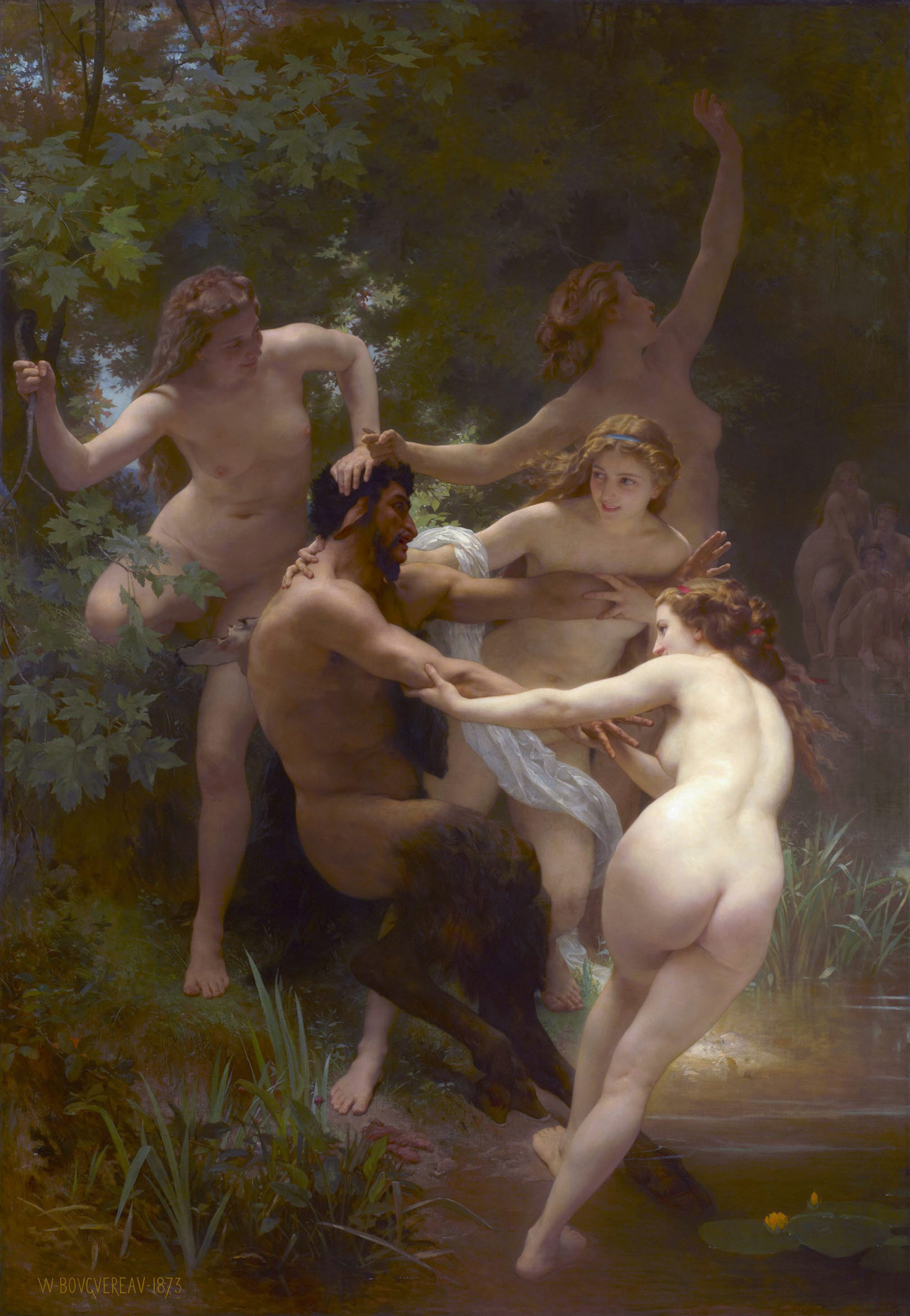
Nymphs and Satyr by William-Adolphe Bouguereau (1873)
Sterling and Francine Clark Art Institute, Williamstown, MAPublic DomainBy and large, nymphs were gentle and benevolent spirits who watched over mortals as well as gods. In many traditions, nymphs were responsible for nursing the gods Zeus and Dionysus when they were still infants. But on some occasions, nymphs could be aggressive lovers, carrying off attractive young mortals like Hylas.
As a vast and varied group, nymphs could be linked with any number of attributes. For example, it was not uncommon for nymphs to be connected in some form with productivity, fertility, childbirth, childcare, and even healing.
Iconography
In ancient art, as in literature, nymphs were represented as beautiful maidens. They were often either scantily clad or completely nude. These nymphs were typically shown in nature or in the wild, sometimes in the company of pans or satyrs or as attendants of Artemis, Hermes, Dionysus, or Apollo.[6]
Family
Early sources such as Homer and Hesiod often referred to the nymphs as daughters of Zeus.[7] The Orphics, meanwhile—a religious community with unorthodox beliefs—sometimes regarded the nymphs as daughters of Oceanus, one of the personifications of the vast sea.[8]
But most authorities ultimately assigned different parents and genealogies to each of the different types of nymphs. The Oceanids, for example, were daughters of Oceanus; the Nereids, of Nereus; the Meliae, like the Erinyes, were born from the blood that spurted from Uranus when he was castrated; and other nymphs were the offspring of the numerous river and sea gods.
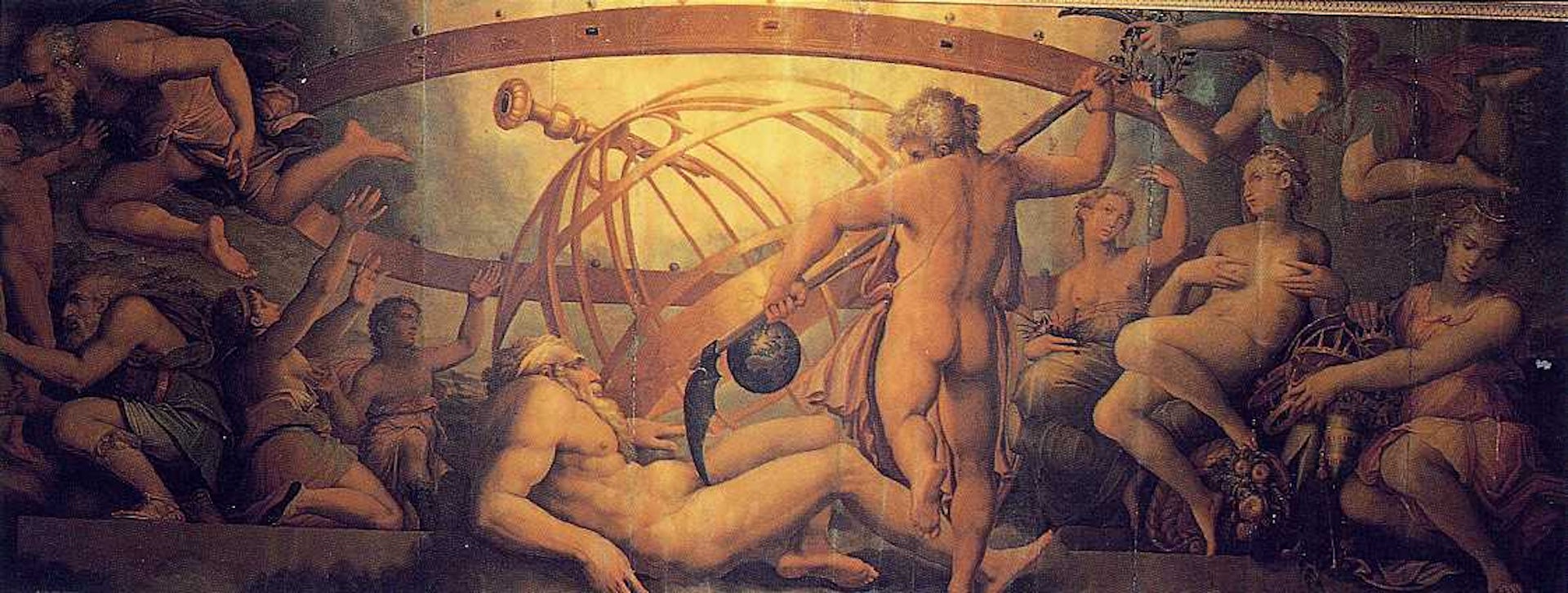
The Mutilation of Uranus by Saturn (Cronus) by Giorgio Vasari (16th century)
Palazzo Vecchio, Florence, ItalyPublic DomainWe also encounter some vague references in Greek literature to “elder” or “eldest” nymphs, suggesting that at some point there was a distinction between “elder” (πρεσβύτεραι, presbyterai) and “younger” (νεώτεραι, neōterai) nymphs.[9] However, it is unclear whether this distinction was significant or widely recognized.
Types of Nymphs
Water Nymphs
Many nymphs lived in various bodies of water, including seas, rivers, lakes, springs, and fountains. Water nymphs could be described collectively as Naiads or Hydriads, but they could also be divided into more specific types by genealogy or geography.
It was sometimes believed that water nymphs endowed the bodies of water they inhabited (especially springs and fountains) with special powers. The exact nature of these powers varied depending on the specific spring or fountain: some, for example, inspired prophetic or musical abilities in those who drank from them,[11] while others had the ability to heal the sick.[12]
The Greeks usually imagined that water nymphs lived in watery caves or grottoes. The Odyssey contains a famous description of the cave of the nymphs on the coast of Odysseus’ island of Ithaca:
Therein are mixing bowls and jars of stone, and there too the bees store honey. And in the cave are long looms of stone, at which the nymphs weave webs of purple dye, a wonder to behold; and therein are also ever-flowing springs. Two doors there are to the cave, one toward the North Wind, by which men go down, but that toward the South Wind is sacred, nor do men enter thereby; it is the way of the immortals.[13]
General Types
Collectively, water nymphs were most often called Naiads (Greek Ναϊάδες, translit. Naïádes; sing. Naiad, Greek Ναϊάς, translit. Naïás) or, occasionally, “Naiad nymphs.”[14] Etymologically, this term seems to come from the Greek verb νάω (náō), meaning “to flow.”[15]
Most of the time, Naiads were freshwater nymphs who inhabited the rivers, lakes, springs, and fountains of the earth. But nymphs of the sea were sometimes called Naiads, too.[16] Many Naiads were the daughters of local river gods.
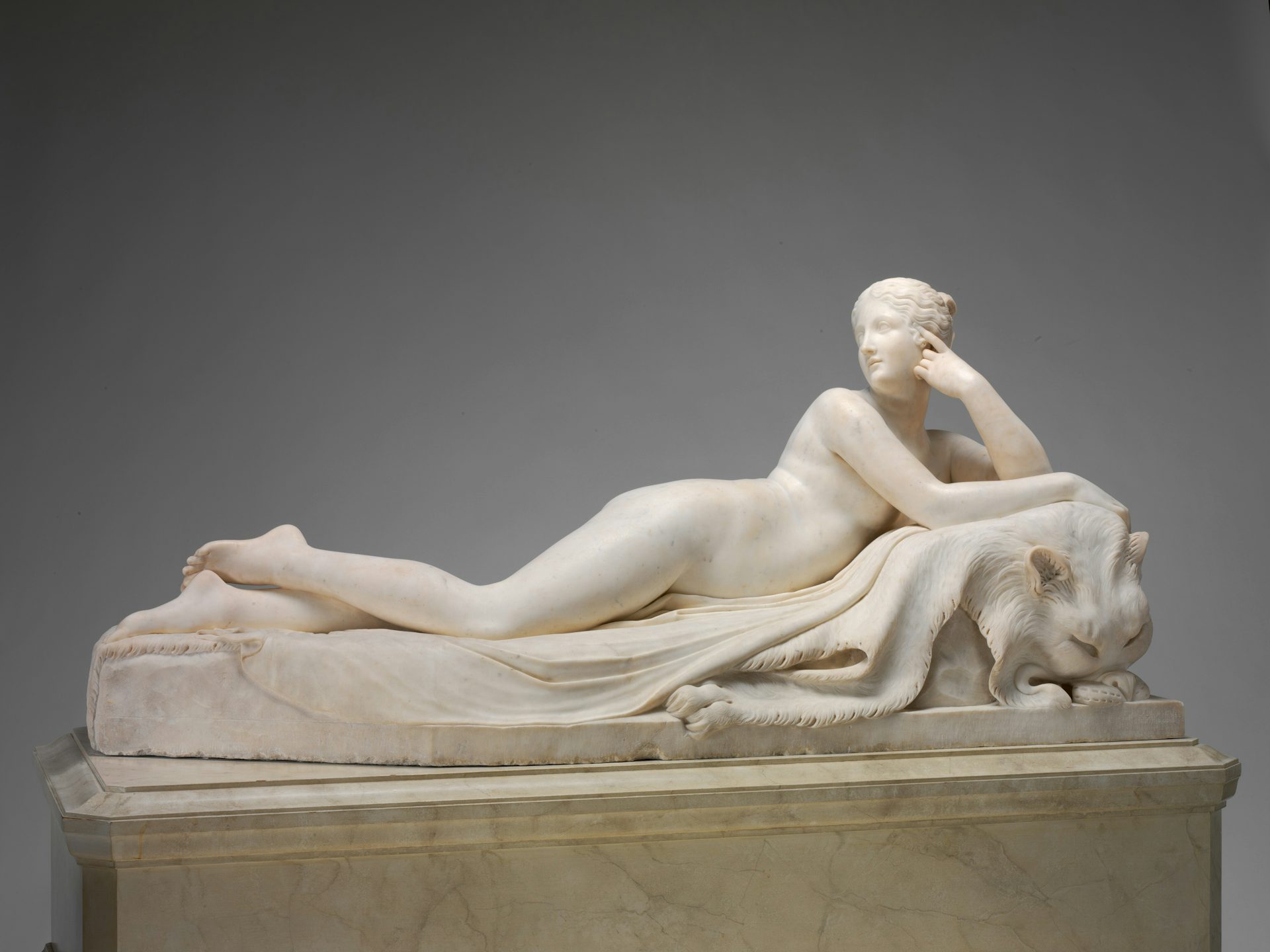
Naiad by Antonio Canova (1815/1817–1820/1823)
National Gallery of Art (US)Public DomainNaiads personified and protected bodies of water. They were usually thought to live in damp caves and grottoes that were either near or underneath bodies of water.[17]
Water nymphs were sometimes also collectively known as Hydriads (Greek Ὑδριάδες, translit. Hydriádes; sing. Hydriad, Greek Ὑδριάς, translit. Hydriás).[18] This term (which is a bit rarer than Naiad and only became prominent in later literature) comes from the Greek word ὕδωρ (hýdōr), meaning “water.”
Specific Types
Nereids
One well-known group of sea nymphs were the Nereids (Greek Νηρηΐδες, translit. Nērēḯdes; sing. Nereid, Greek Νηρηΐς, translit. Nērēḯs). These Nereids—all fifty of them—were daughters of Nereus, the so-called “OId Man of the Sea,” and his wife, the Oceanid Doris.[19] They were commonly regarded as kind, helpful deities. The most important individual Nereids were Amphitrite, Thetis, Psamathe, and Galatea.
Oceanids
The Oceanids (Greek Ὠκεανίδες, translit Ōkeanídes; sing. Oceanid, Greek Ὠκεανίς, translit. Ōkeanís) were the three thousand daughters of the Titans Oceanus and Tethys.[20] Their classification varied depending on the source, but they were typically represented as young and beautiful and were therefore sometimes counted among the nymphs.
Like their father Oceanus—the personification of the world-encircling “Ocean”—the Oceanids were associated with the sea. One of their main functions was to care for the young. A handful of individual Oceanids, such as Styx, Doris, Clymene, Dione, and Metis, had myths of their own.

Les Océanides by Gustave Doré (ca. 1860–1869)
Wikimedia CommonsPublic DomainOther Water Nymphs
Other water nymphs were classified by the bodies of water they inhabited. A few of the better known examples are listed below:
“Potamids” (ποταμηίδες, potamēídes)[21] or “epipotamids” (ἐπιποταμίδες, epipotamídes)[22] were river nymphs (from the Greek πόταμος/pótamos, meaning “river”).
“Crenaeae” (κρηναῖαι, krēnaîai)[23] or “pegaeae” (πηγαῖαι, pēgaîai)[24] were nymphs of springs or fountains (from the Greek κρῆναι/krênai and πηγαί/pēgaí, both meaning “spring” or “fountain”).
“Limnads” (λιμνάδες, limnádes)[25] or “heleionomoi”(ἑλειονόμοι, heleionómoi)[26] were nymphs of marshes (from the Greek λίμνη/límnē and ἕλος/hélos, both meaning “marsh”).
“Haliae” (ἅλιαι, háliai)[27] or “thalassiae” (θαλάσσιαι, thálassiai)[28] were nymphs of the sea (from the Greek ἅλς/háls and θάλασσα/thálassa, both meaning “sea”).
Land Nymphs
Just as the waters of the earth teemed with nymphs, so too did the land; nymphs lived everywhere from the tallest mountains to the deepest caves to the darkest forests. These nymphs were usually named after the geographical features they inhabited and represented.
Land nymphs presided over many activities that took place in and around their wild homes, including herding, beekeeping, hunting, and quarrying. They were often seen in the company of other woodland gods like Pan or Artemis.
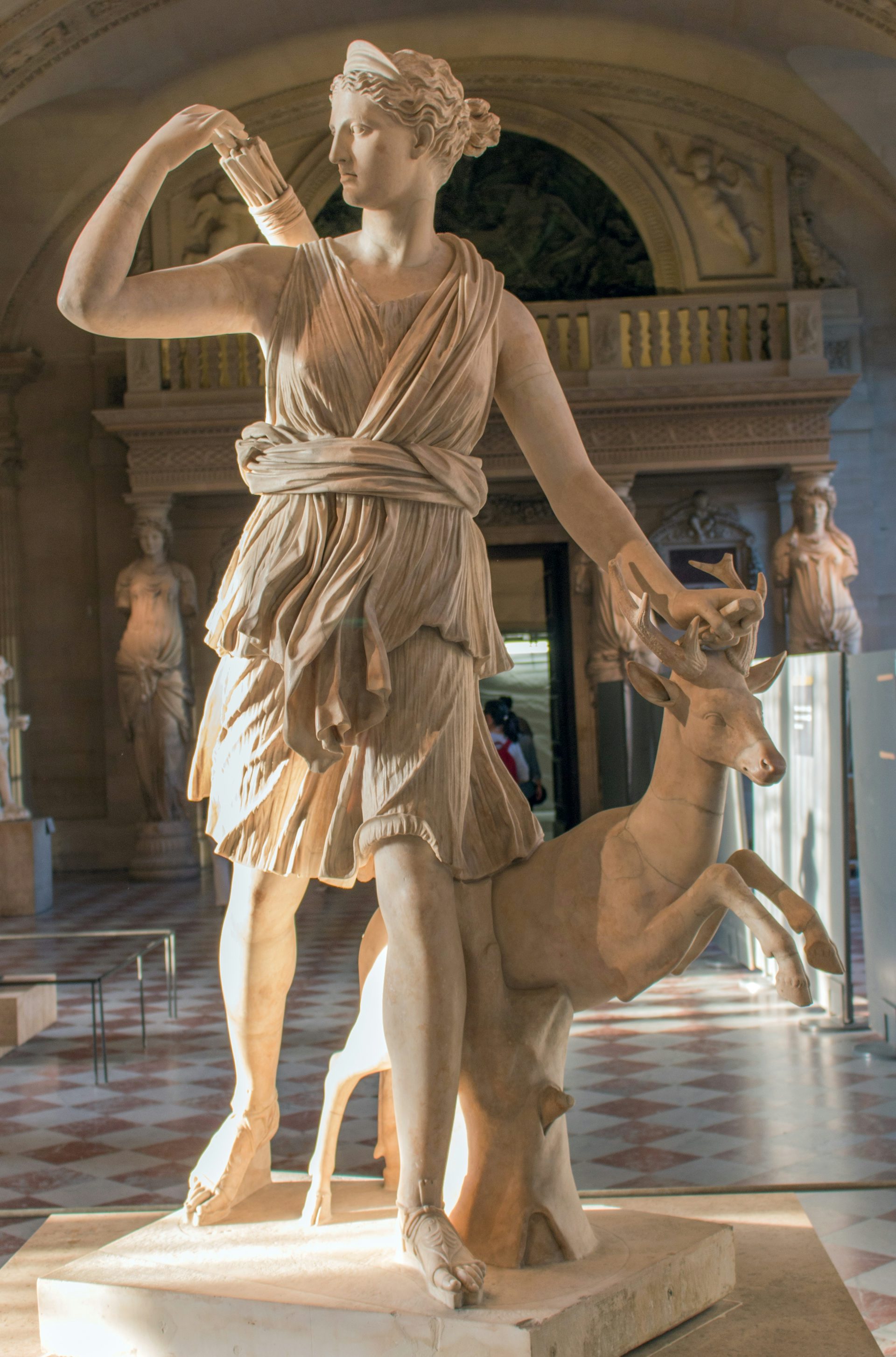
The "Diana of Versailles," also known as "Artemis with a Hind," Roman copy from the first or second century CE, based on a Greek original. The chaste Daphne was a devotee of the virgin goddess Artemis.
Keroen van Luin, FlickrCC BY 2.0Like water nymphs, land nymphs could be classified either generally or specifically. Thus, some sources referred to all nymphs who lived on land as epígeioi (ἐπίγειοι, “those of the land”).[29] They were sometimes also called by general terms meaning “those of the wild” or “those who dwell in the wild,” including ἀγρονόμοι (agronómoi),[30] ἀγριάδες (agriádes),[31] and ἀγρωστῖναι (agrōstînai)[32]—or, in Latin, agrestes (an epithet that means much the same thing).[33]
It was also common practice to divide the many groups of land nymphs into more specific types according to where they lived or, occasionally, their function.
Mountain Nymphs
The nymphs who lived in the mountains were often collectively called Oreads (Greek Ὀρειάδες, translit. Oreiádes; sing. Oread, Greek Ὀρειάς, translit. Oreiás).[34] This term comes from the Greek word ὄρος (óros), meaning “mountain.”
Mountain nymphs boasted numerous titles and epithets that reflected their connection with their home. Naturally, most of these contained some form of the element ὄρος (óros). Mountain nymphs could thus be called ὀρεστιάδες (orestiádes, “of the mountains”),[35] ὀρεσσίγονοι (oressígonoi, “mountain-born”),[36] and ὄρειαι (óreiae) or οὔρειαι (oúreiai) (“of the mountains”),[37] among other things.
Other possible names or epithets for the Oreads included ἀκραῖαι (akraîai), which means “of the heights,”[38] and πετραῖαι (petraîai), “of the rocks.”[39]
Oreads seem to represent the broadest and most general group of land nymphs (probably due to the mountainous geography of Greece). Indeed, the Oreads were often said to encompass the other categories of land nymphs (tree nymphs, grove nymphs, etc.), and even occasionally some water nymphs with connections to the mountains.
Many mountain nymphs had further titles derived from the mountains where they lived. For example, the Cithaeronides (or Sphragitides) were nymphs of Mount Cithaeron in Boeotia who were said to possess oracular powers;[40] the Coryciae, daughters of a certain Pleistus, were nymphs of the Corycian Cave on Mount Parnassus who were associated with Pan.[41]
Woodland Nymphs
Also important were the many nymphs who filled the woodlands and forests. These were sometimes known by various general terms meaning “those of the woodlands” (or something roughly equivalent), including ὑλονόμοι (hylonómoi)[42] or ὑληωροί (hylēōroí)[43]—from the Greek ὕλη (hýlē, “wood”); δρυμίδες (drymídes)[44] or δρυμοχαρεῖς (drymochareîs)[45]—from the Greek δρῦς (drûs, “tree, oak tree”); and δενδρώδεις (dendrṓdeis)[46] or δενδρίτιδες (dendrítides)[47]—from the Greek δένδρον (déndron, “tree”).
But some woodland nymphs were more specific. There were nymphs of groves, called Alseids (Greek Ἀλσηίδες, translit. Alsēídes);[48] nymphs of meadows, called Leimoniads (Greek Λειμωνιάδες, translit. Leimōniádes);[49] and nymphs of glens (known only from Latin literature), called Napaeae.[50] Nymphs who dwelled in valleys could be called αὐλωνίαδες (auloníades, “of the valley”);[51] those who lived in the plains (again known only from Latin literature) could be called pediades (“of the plains”);[52] and so on.
Tree Nymphs
Nymphs who lived in specific trees formed a class of their own. The most famous of these were the Dryads (Greek Δρυάδες, translit. Dryádes; sing. Dryad, Greek Δρυάς, translit. Dryás)[53] and Hamadryads (Greek Ἁμαδρυάδες, translit. Hamadryádes; sing. Hamadryad, Greek Ἁμαδρυάς, translit. Hamadryás).[54] They were perhaps originally conceived as nymphs who lived in oak trees (their name comes from the Greek word for “oak tree”) but eventually came to represent all nymphs who lived in specific trees.

The Woodcutter and the Hamadryad Aigeiros by Émile Bin (1870)
Musée Thomas-Henry, Manche, FrancePublic DomainSome tree nymphs were grouped by the type of trees or plants they inhabited. For instance, the Meliae (Μελίαι, Melíai) were probably originally nymphs of ash trees (they share their name with the Greek word for “ash tree”). But much like Dryads and Hamadryads, it seems that they eventually came to represent tree nymphs in general.[55]
Tree nymphs had an especially close connection with the place where they lived. This was particularly true of Hamadryads, who were born in their tree, lived in their tree, and died with their tree:
… at their birth pines or high-topped oaks spring up with them upon the fruitful earth, beautiful, flourishing trees, towering high upon the lofty mountains (and men call them holy places of the immortals, and never mortal lops them with the axe); but when the fate of death is near at hand, first those lovely trees wither where they stand, and the bark shrivels away about them, and the twigs fall down, and at last the life of the Nymph and of the tree leave the light of the sun together.[56]
Celestial Nymphs
Some sources also spoke of “heavenly” nymphs (οὐράνιαι, ouraniai)—that is, nymphs who were somehow associated with the celestial realm.[57] This is most likely a reference to the Hyades and Pleiades, female goddesses linked to certain clusters of stars, and perhaps also to the Hesperides, who were linked to the evening and sunset. Indeed, the Hesperides, Hyades, and Pleiades shared many attributes with the other nymphs, including their youthfulness, beauty, and divine parentage.
Other groups of heavenly goddesses were also connected with the nymphs, including the Muses, the Horae, and the Charites (Graces). But though these goddesses closely resembled nymphs and may have even had similar historical origins, they were not typically counted as nymphs themselves.
Local Nymphs
Another way to classify nymphs was by the place or region where they lived. Thus, the Dodonides were nymphs from Dodona in western Greece;[58] the Thessalides were nymphs from the region of Thessaly in northern Greece;[59] the Nysaeae or Nysiads were nymphs of Mount Nysa in Anatolia;[60] and so on. Like other classifications, these labels were not exclusive (meaning nymphs could belong to more than one category at once).
Other nymphs were “eponymous,” meaning a city, region, or landmark was named after them. Some important examples of eponymous nymphs include Aetna,[61] Aegina,[62] Cyrene,[63] Nemea,[64] Sparta,[65] and Thebe.[66]
Other Nymphs
Nymphs could be found in every corner of the Greek cosmos. We thus hear of several other types of nymphs, in addition to those already listed:
Nymphs who protected herds and livestock were known as Epimelides (Ἐπιμηλίδες, Epimēlídes),[67] Hamamelides (Ἁμαμηλίδες, Hamamēlídes),[68] or Perimelides.[69]
Some nymphs were responsible for childcare and the protection of the young. According to the Roman commentator Servius, these were called curotrophae (“those who nurse the young”).[70]
Other nymphs belonged to the entourages of powerful gods. For instance, the Maenads—frenzied young females who accompanied Dionysus, the god of inebriation—could be counted as nymphs.[71]
There were other nymphs who were connected with the Underworld. Menthe or Minthe, for instance, was a nymph who was a lover of Hades; she was sometimes said to have been transformed into a plant by Hades’ jealous wife Persephone (hence the origin of “mint”).[72] One early poet also mentions a group of nymphs known as Lampads, who seem to have been torch-bearing nymphs who accompanied the Underworld goddess Hecate.[73]
Mythology
Nymphs and the Gods
The nymphs, as minor goddesses or divinities of the natural world, were often found in the company of other gods. They roamed the woodlands with Pan, the satyrs, and the silens; they watched over flocks with Apollo and Hermes; they drank and reveled with Dionysus; the more virginal ones hunted with Artemis; and the less virginal ones attended Aphrodite.
It was also common for nymphs to become lovers of gods—whether willingly or not. The image of lustful satyrs or silens pursuing nymphs through the woods was a common one in ancient literature as well as art.
One myth tells of how the rustic god Pan, who had the horns and lower body of a goat, tried to win over the nymph Syrinx. Syrinx fled from him as far as the River Ladon, until she could go no further. Desperate, she called upon the gods to help her escape and was turned into river reeds. Pan used these reeds to fashion his favorite instrument, which he named the “syrinx” after his would-be lover.[75]
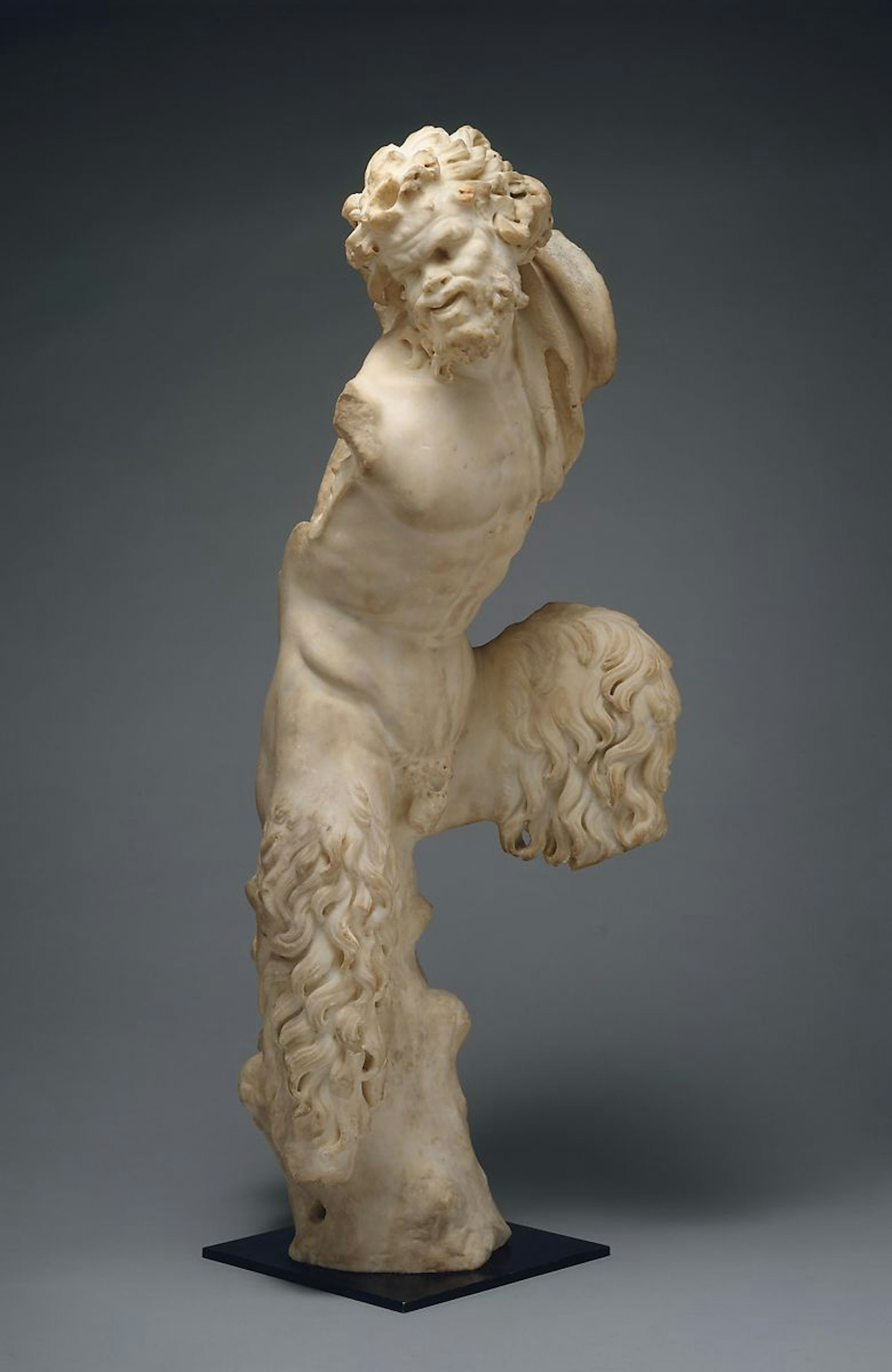
Roman statue of Pan (first century CE), a woodland god who loved Echo
The Metropolitan Museum of ArtPublic DomainA similar story is told about the nymph Daphne. Apollo, the god of art, prophecy, and healing, had fallen in love with Daphne, but Daphne did not share his feelings. She ran from him, just as Syrinx had run from Pan. Also like Syrinx, she only escaped by being transformed by the gods—in this case, into a laurel tree. But Apollo still loved Daphne, and so the laurel became his sacred tree.[76]
Zeus, the greatest of all the gods, also loved several nymphs, though the results were often unhappy. The nymphs Callisto and Io, for instance, ended up transformed into wild animals as a result of their affairs with Zeus (Callisto into a bear, Io into a cow).[77]
In other myths, the nymphs acted as nurses of the Greek gods. Zeus himself was entrusted to nymphs when he was a baby hiding from his murderous (and cannibalistic) father Cronus. In one familiar tradition, the nymphs who nursed Zeus were named Adrastia, Ida, and Amalthea. They fed Zeus with the milk of Amalthea’s goat (though in some versions, Amalthea was actually the name of the goat). They also had help from the Curetes, male warriors who danced and clashed their arms so that Cronus would not hear Zeus’ cries.[78]
Another important god nursed by nymphs was Dionysus, the god of wine, inspiration, and intoxication. In what probably became the best-known tradition, Dionysus was cared for by the nymphs who inhabited a place called Nysa—sometimes called the “Nysaeae” or “Nysiad” nymphs.[79] But others said that the nurses of Dionysus were the nymphs who lived in Dodona, who later became the Hyades;[80] still others claimed that they were the nymphs of the island of Naxos[81] (among other versions).[82]
Whoever they were, these nymph nurses were believed to have taught Dionysus many important agricultural skills—skills he would eventually use to discover the grapevine. When Dionysus became a god, the nymphs were among his first followers.[83]
Nymphs and Mortals
Nymphs interacted with mortals far more frequently than most gods and goddesses. Often these interactions were pleasant, but in some cases they ended in violence or despair.
It was not uncommon for particularly impressive mortals or heroes to take nymphs as their wives or lovers. Orpheus, the greatest musician of Greek mythology, married Eurydice, who was sometimes called a nymph. When Eurydice died on her and Orpheus’ wedding day (like many nymphs, Eurydice was not immortal), Orpheus descended to the Underworld in a failed attempt to bring her back.[84]
Some nymphs, however, did not want to demean themselves by sleeping with or marrying mortals, whom they deemed below their station. This meant that mortals sometimes used force to capture or rape nymphs. The hero Peleus, for example, won the Nereid Thetis as his bride by grabbing and holding on to her as she tried to escape by changing into different shapes.[85] A similar story is told of Peleus’ father Aeacus, who captured Thetis’ sister Psamathe.[86]
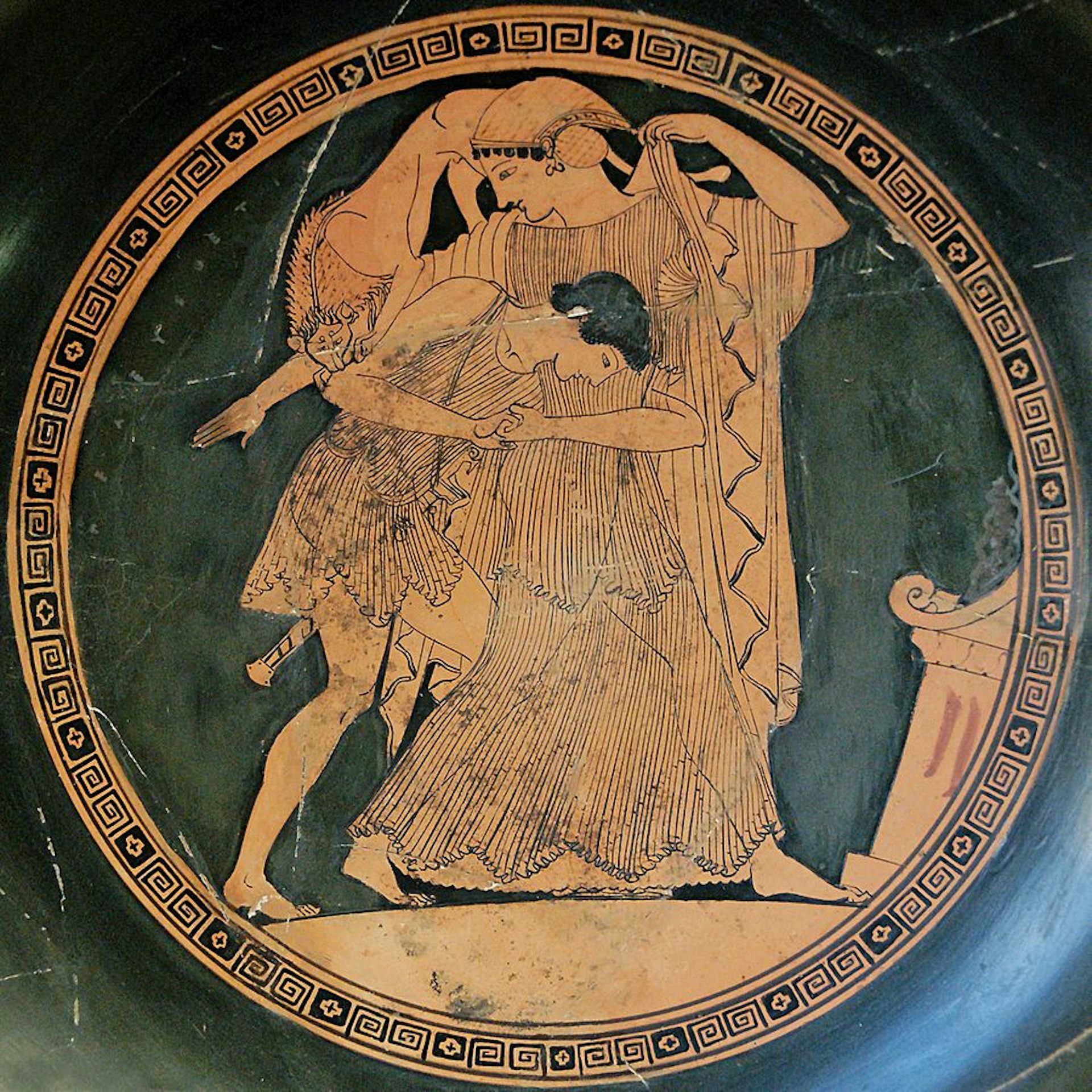
Detail from an Attic red-figure kylix showing Peleus capturing Thetis as she changes shape, attributed to Douris (ca. 490 BCE)
Cabinet des Médailles, Paris / JastrowPublic DomainIn other myths, these roles were reversed: it was a nymph who fell in love with a mortal, and the mortal who did not return her love. The mountain nymph Echo, for instance, fell in love with the handsome Narcissus. When Narcissus rejected her, the heartbroken Echo wasted away into a voice reverberating through the woodlands—the original “echo.”[87]
Other tales of love affairs between nymphs and mortals actually cast the nymphs as the aggressors. Take, for instance, the myth of Hylas. Hylas was one of the Argonauts and a companion (or lover) of Heracles, but he disappeared during one of the Argonauts’ landfalls. It turned out that he had been kidnapped by local water nymphs, who were stunned by his beauty.[88]
In another myth, the nymph Salmacis became smitten with the youth Hermaphroditus, son of Hermes and Aphrodite. She attacked him while he was bathing in a pool and asked the gods to unite them forever. Immediately, Hermaphroditus and Salmacis became a single creature, half-man and half-woman.[89]
Nymphs could also be jealous lovers. In one story, a nymph (her name varies across different sources) fell in love with the handsome shepherd Daphnis. She warned Daphnis that if he was ever unfaithful to her, he would go blind. But one night, the daughter of a king made Daphnis drunk and seduced him. The nymph kept her word, and Daphnis promptly lost his sight.[90]
Nymphs were the mothers or ancestors of many heroes, and even of whole communities. Aegina, a nymph loved by Zeus, gave her name to an island kingdom in the Saronic Gulf and gave birth to a line of many important heroes (including Aeacus, Peleus, Telamon, Achilles, and Ajax the Greater).[91] Many Boeotian and Laconian cities likewise traced their ancestry to nymphs, as did the warlike Amazons.
In other myths, nymphs gave valuable help to heroes as they carried out their quests. According to some accounts, nymphs helped Perseus find the items he would need to kill the Gorgon Medusa (a magical satchel, cap of invisibility, and winged sandals).[92] A similar myth told of how the nymphs of Eridanus revealed to Heracles where he could find the sea god Nereus, the only being who could tell him the location of the Garden of the Hesperides.[93]
In another myth, the bee nymphs of Ceos (sometimes called the Brisae) taught Aristaeus the arts of herdsmanship and beekeeping. Aristaeus eventually became an important “hero” by teaching what he had learned from the nymphs to other mortals.[94]
Though they were usually gentle and kind creatures, nymphs did not hesitate to punish those who crossed them. One myth tells of how a Thessalian king named Erysichthon cut down a tree (or grove of trees) sacred to the nymphs. The nymphs denounced him to the Olympian goddess Demeter, who punished Erysichthon with insatiable hunger. Erysichthon quickly ate himself out of house and home, and ultimately consumed his own flesh.[95]
Worship
The sanctuaries of the nymphs, called “nymphaea” (singular “nymphaeum”), were usually found in watery caves and grottoes. Later, under the Romans, nymphaea became more elaborate constructions.
We know of nymph sanctuaries or nymphaea in many parts of Greece. One famous example is the Corycian Cave at Delphi. Here, many thousands of votive offerings have been found, including figurines, small vessels (called aryballoi), and knucklebones.[96]
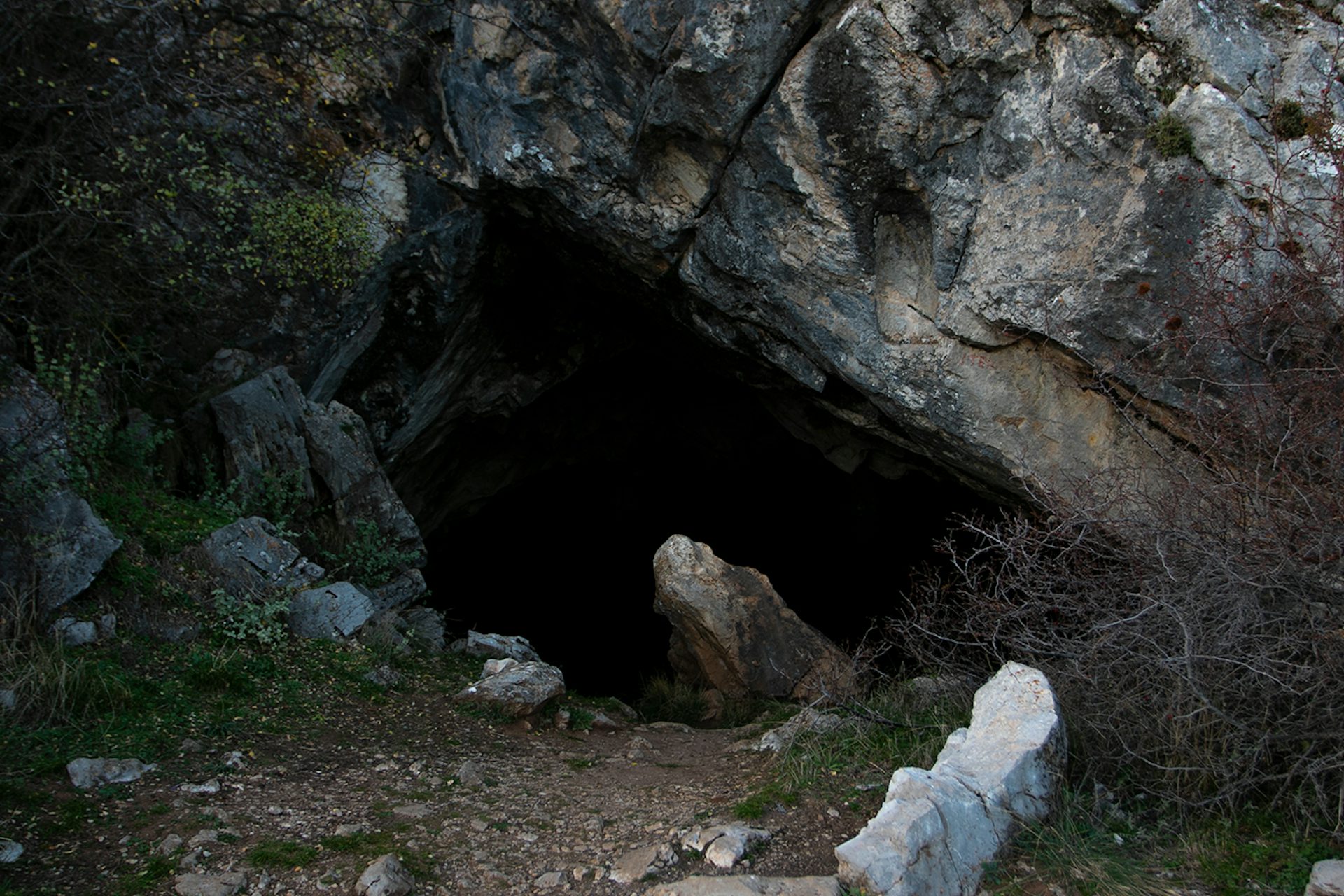
The entrance to the Corycian Cave in Mount Parnassus near Delphi
Claire KittridgeCC BY-SA 4.0Nymphs were also associated with prophecy and oracles, and some nymphaea may have even delivered prophecies. There was a nymphaeum in Apollonia in Illyria, for example, that gave prophecies in the form of “yes” or “no” answers to requests posed by petitioners.[97] Some scholars have argued that the important nymphaeum of the Corycian Cave may have also had an oracular function.[98]
In other places, such as the cave sanctuaries at Mount Hymettus in Attica[99] and Lera in Crete,[100] nymphs were worshipped alongside fellow rustic gods like Pan and Apollo. Nymphs were also worshipped in conjunction with other gods, including Artemis, Dionysus, and Hermes.
Nymph cults were usually local and connected with a specific spot. In some cases, however, the nymphs became part of the state cult. There was, for instance, a fountain house of the nymphs in the Athenian agora. In addition, the Dorian tribes (especially the Dymanes, but also the Hylleis) of the islands of Thera and Cos honored the nymphs with public sacrifices.[101]
Pop Culture
Nymphs occasionally appear in modern pop culture, though they are not nearly as prevalent as many other figures from Greek myth. Some modern adaptations of Greek mythology, including Rick Riordan’s Percy Jackson and the Olympians novels, feature nymphs as helpful and benevolent deities. Nymphs also appear among the mythical creatures of C. S. Lewis’ The Chronicles of Narnia, as well as in the role-playing fantasy game Dungeons and Dragons.
But nymphs are probably best known today as symbols of female sexuality. The term “nymphomaniac” is used—often pejoratively—to refer to hypersexual women (the term is no longer deployed in clinical settings, but it is still widely familiar). A related word, “nymphet,” denotes a sexually precocious girl and was popularized by Vladimir Nabokov’s 1955 novel Lolita.
In biology, the term “nymph” refers to a type of insect that changes very little as it matures. Some examples include dragonflies, mayflies, and locusts.